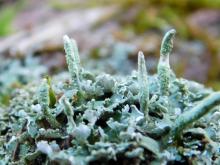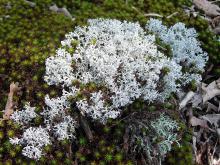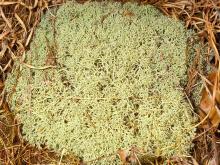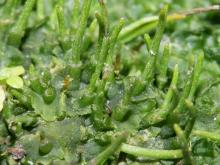Mosses, Liverworts, and Lichens
Media

Species Types
Scientific Name
Cladonia coniocraea
Description
Common powderhorn’s slender, gray-green, hornlike fruiting structures emerge from a carpet of gray-green, scalelike squamules. This lichen usually grows on old, damp wood, often on tree bases, in shady areas.
Media

Species Types
Scientific Name
Cladina rangiferina (syn. Cladonia rangiferina)
Description
Gray reindeer lichen, also called reindeer moss, takes the form of bright ashy or silvery-gray, branching cushions that grow on the soil. The branch tips usually bend to point in the same direction, as if combed or blown by a strong wind.
Media

Species Types
Scientific Name
Cladina subtenuis (syn. Cladonia subtenuis)
Description
Dixie reindeer lichen, also called reindeer moss, takes the form of pale yellow-green, finely branched cushions that grow on the soil. This is the most common and widespread of Missouri’s reindeer lichen species.
Media

Species Types
Scientific Name
4 species in Missouri
Description
With their flattened, green forms, hornworts resemble liverworts, but their spore-bearing structures are elongated and horn-shaped. As with liverworts and mosses, hornworts make forest floors, streamsides, and spring openings beautiful.
Media

Species Types
Scientific Name
Marchantia polymorpha
Description
Umbrella liverwort is the most famous liverwort in the world. It grows in green ribbons and is very common on the soil of potted plants. It typically forms cuplike gemmae on its upper surface. Its palm-tree-shaped archegona are distinctive, too.
Media

Species Types
Scientific Name
Thuidium spp.
Description
Easy to identify, fern mosses look like tiny ferns. Just like many fern fronds, the branches lie on one plane and become shorter toward the tips. They even lean over like fern fronds.
Media

Species Types
Scientific Name
About 436 species in Missouri
Description
A lichen is a composite organism formed by certain fungus species that join with certain algae species. Lichens can be many colors and can be crusty, leaflike, flaky, branching, or mossy. They grow on rocks, trees, or other surfaces.
Media

Species Types
Scientific Name
Entodon seductrix
Description
Glossy moss, or shiny or seductive endoton, is a common Missouri moss with broad, glossy leaves that are pressed tightly against the stems. It forms large, dense mats that sometimes cover an entire boulder or log.
Media

Species Types
Scientific Name
Atrichum spp.
Description
Missouri has five species of starburst mosses (genus Atrichum). They tend to look different depending on whether they are wet or dry. When wet, they look like mass of bright green stars, but when dry, the leaves shrivel, contort, and look dead.
Media

Species Types
Scientific Name
Polytrichum juniperinum
Description
Juniper haircap moss is common and easy to recognize, since it looks like a tiny forest of juniper sprigs. It’s called a haircap moss because the young capsules have densely hairy caps.
See Also
About Mosses, Liverworts, and Lichens in Missouri
Mosses, liverworts, hornworts, and lichens seem rather similar, but these organisms are in very different groups. Mosses, liverworts, and hornworts are small, low plants usually found in damp habitats. Unlike more familiar plants, they lack veinlike structures and do not produce flowers or seeds — instead, they produce spores. Meanwhile, lichens are not plants at all: they are a collection of different fungi that have photosynthetic algae living within their tissues.





















